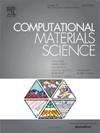Quantitative analysis of the prediction performance of a Convolutional Neural Network evaluating the surface elastic energy of a strained film
IF 3.1
3区 材料科学
Q2 MATERIALS SCIENCE, MULTIDISCIPLINARY
引用次数: 0
Abstract
A Deep Learning approach is devised to estimate the elastic energy density at the free surface of an undulated stressed film. About 190000 arbitrary surface profiles are randomly generated by Perlin noise and paired with the corresponding elastic energy density profiles , computed by a semi-analytical Green’s function approximation, suitable for small-slope morphologies. The resulting dataset and smaller subsets of it are used for the training of a Fully Convolutional Neural Network. The trained models are shown to return quantitative predictions of , not only in terms of convergence of the loss function during training, but also in validation and testing, with better results in the case of the larger dataset. Extensive tests are performed to assess the generalization capability of the Neural Network model when applied to profiles with localized features or assigned geometries not included in the original dataset. Moreover, its possible exploitation on domain sizes beyond the one used in the training is also analyzed in-depth. The conditions providing a one-to-one reproduction of the “ground-truth” profiles computed by the Green’s approximation are highlighted along with critical cases. The accuracy and robustness of the deep-learned are further demonstrated in the time-integration of surface evolution problems described by simple partial differential equations of evaporation/condensation and surface diffusion.

求助全文
约1分钟内获得全文
求助全文
来源期刊

Computational Materials Science
工程技术-材料科学:综合
CiteScore
6.50
自引率
6.10%
发文量
665
审稿时长
26 days
期刊介绍:
The goal of Computational Materials Science is to report on results that provide new or unique insights into, or significantly expand our understanding of, the properties of materials or phenomena associated with their design, synthesis, processing, characterization, and utilization. To be relevant to the journal, the results should be applied or applicable to specific material systems that are discussed within the submission.
 求助内容:
求助内容: 应助结果提醒方式:
应助结果提醒方式:


